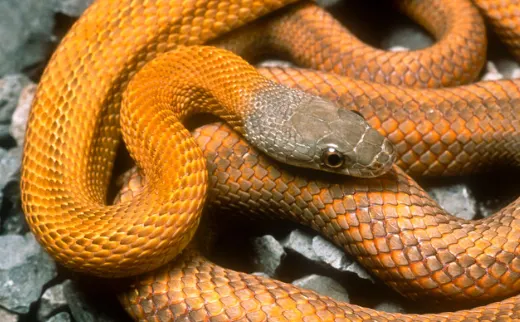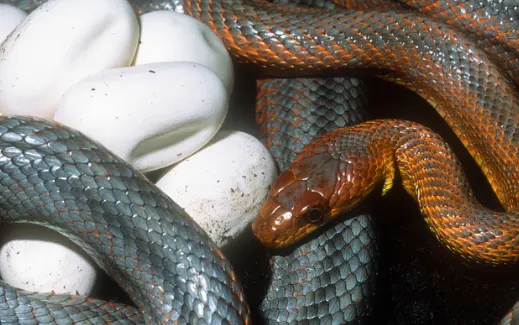Native to the rugged terrains of the Big Bend region along the Texas-Mexico border, the Baird’s rat snake (Pantherophis bairdi) is a fascinating and elusive reptile. Known for its striking coloration and ease of care in captivity, this snake has intrigued herpetologists and snake enthusiasts alike.
Table of Contents
Scientific Classification
- Kingdom: Animalia
- Phylum: Chordata
- Class: Reptilia
- Order: Squamata
- Family: Colubridae
- Genus: Pantherophis
- Scientific Name: Pantherophis bairdi
Conservation Status
- IUCN Red List: Least Concern

Habitat and Distribution
Baird’s rat snake is predominantly found in the dry, rocky habitats of the Big Bend region, an area that provides ample cover and hunting grounds. This habitat, characterized by its arid conditions and sparse vegetation, is ideal for a snake that relies heavily on stealth and camouflage.
Physical Characteristics
Baird’s rat snake is medium-sized, typically growing between 3 to 5 feet in length. Its most distinctive features include an orange, yellow, or salmon-colored back adorned with four dark stripes running the length of its body. The belly is a lighter gray or yellow, darkening towards the tail. The snake has a small head with little distinction from its neck, a trait common among rat snakes.
Behavior and Diet
Baird’s rat snake is non-venomous and subdues its prey through constriction. Its diet mainly consists of rodents, birds, and occasionally lizards. In captivity, juvenile snakes are fed pinkie mice or rats every five to seven days, while adults are fed larger rats every seven to ten days.
Reproduction and Lifespan
The breeding season for Baird’s rat snake occurs during the summer months. Females lay clutches of up to 10 eggs, which hatch after about three months. The species shows minimal parental care, with hatchlings being independent from birth. In captivity, Baird’s rat snake can live between eight to sixteen years.
Color Morphs and Variants
In addition to its natural coloration, Baird’s rat snake can exhibit several rare color morphs. These include melanistic (lacking black pigments), leucistic (white with blue eyes), and pure albino variants. These morphs are uncommon in the wild but are often bred and sold in captivity.
Safety and Human Interaction
Despite its intimidating defensive behaviors, such as vibrating its tail to mimic a rattlesnake and releasing a potent musk, Baird’s rat snake poses no real threat to humans. Its bite, while potentially painful, is non-venomous. With regular handling, captive Baird’s rat snakes can become quite docile and make excellent pets for snake enthusiasts.
Caring for Baird’s Rat Snake in Captivity
For those interested in keeping a Baird’s rat snake as a pet, they require a moderately sized enclosure (minimum 3 feet by 2 feet by 2 feet) with appropriate hiding spots. The enclosure should have a warm side set at 85 degrees Fahrenheit and a cool side at 70-75 degrees. Humidity should be maintained at 50%. The substrate can be aspen bedding, cypress mulch, coco fiber, or even newspaper. Regular, gentle handling is recommended to help the snake acclimate to human interaction.
Baird’s rat snake is a remarkable species, blending unique physical characteristics with fascinating behaviors. Whether in the wilds of the Big Bend region or as a cherished pet, this snake continues to captivate those who study and care for it.

Q&A
Q: Are Baird’s rat snakes venomous?
A: No, Baird’s rat snakes are non-venomous and kill their prey through constriction.
Q: What do Baird’s rat snakes eat?
A: In the wild, they primarily eat rodents, birds, and lizards. In captivity, they can be fed mice or rats.
Q: How long do Baird’s rat snakes live?
A: They typically live between eight to sixteen years in captivity.
Q: Can you keep a Baird’s rat snake as a pet?
A: Yes, they are known for their ease of care and can make good pets for beginners with proper enclosure and handling.
Q: What are the distinct color morphs of Baird’s rat snakes?
A: They include melanistic, leucistic, and pure albino morphs, though these are rare in the wild.
- Enchi Ball Python: A Unique and Stunning Morph of Python regius - March 27, 2025
- Emerald Tree Monitor: The Enigmatic Green Guardian of the Rainforest - March 26, 2025
- The Egyptian Cobra (Naja haje): A Fascinating Serpent - March 25, 2025
